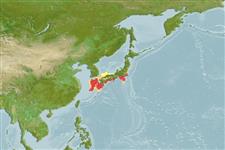>
Eupercaria/misc (Various families in series Eupercaria) >
Lutjanidae (Snappers) > Apsilinae
Etymology: Paracaesio: Greek, para = the side of + Latin, caesium = bluish grey (Ref. 45335).
Environment: milieu / climate zone / depth range / distribution range
Écologie
marin démersal; profondeur 100 - 355 m (Ref. 86942). Subtropical; 37°N - 29°N, 126°E - 142°E (Ref. 55)
Western Pacific: known only from southern Japan. More recently reported from Taiwan (Ref. 5193) and the Chesterfield Islands (Ref. 11897).
Taille / Poids / Âge
Maturity: Lm ? range ? - ? cm
Max length : 50.0 cm TL mâle / non sexé; (Ref. 55); common length : 30.0 cm TL mâle / non sexé; (Ref. 55)
Épines dorsales (Total): 10; Rayons mous dorsaux (Total): 10; Épines anales 3; Rayons mous anaux: 8. Eye large. Snout short, about equal to, or shorter than eye diameter. Interorbital space convex. Pectoral fins long reaching level of anus. Scale rows on back parallel to lateral line. Back and sides blue becoming whitish or silvery ventrally; the dorsal and caudal fins pale yellow; the other fins whitish or translucent.
Adults occur over rocky bottoms at depths exceeding 100 m. An important foodfish. Marketed fresh.
Life cycle and mating behavior
Maturité | Reproduction | Frai | Œufs | Fécondité | Larves
Allen, G.R., 1985. FAO Species Catalogue. Vol. 6. Snappers of the world. An annotated and illustrated catalogue of lutjanid species known to date. FAO Fish. Synop. 125(6):208 p. Rome: FAO. (Ref. 55)
Statut dans la liste rouge de l'IUCN (Ref. 130435)
Menace pour l'homme
Harmless
Utilisations par l'homme
Pêcheries: commercial
Plus d'informations
Noms communsSynonymesMétabolismePrédateursÉcotoxicologieReproductionMaturitéFraiRassemblement de ponteFéconditéŒufsDéveloppement de l'œuf
Taille/ÂgeCroissanceLongueur-poidsLongueur-longueurFréquences de longueursMorphométrieMorphologieLarvesDynamique des populations larvairesRecrutementAbondanceBRUVS
RéférencesAquacultureProfil d'aquacultureSouchesGénétiqueElectrophoresesHéritabilitéPathologiesTraitementNutrientsMass conversion
CollaborateursImagesStamps, Coins Misc.SonsCiguateraVitesseType de nageSurface branchialeOtolithesCerveauxVision
Outils
Articles particuliers
Télécharger en XML
Sources Internet
Estimates based on models
Phylogenetic diversity index (Ref.
82804): PD
50 = 0.5039 [Uniqueness, from 0.5 = low to 2.0 = high].
Bayesian length-weight: a=0.01259 (0.00582 - 0.02724), b=3.05 (2.86 - 3.24), in cm total length, based on LWR estimates for this (Sub)family-body shape (Ref.
93245).
Niveau trophique (Ref.
69278): 3.4 ±0.45 se; based on food items.
Résilience (Ref.
120179): Milieu, temps minimum de doublement de population : 1,4 à 4,4 années (Preliminary K or Fecundity.).
Fishing Vulnerability (Ref.
59153): Moderate vulnerability (40 of 100).
Nutrients (Ref.
124155): Calcium = 70.5 [26.2, 153.7] mg/100g; Iron = 1.13 [0.60, 2.15] mg/100g; Protein = 18.5 [16.6, 20.2] %; Omega3 = 0.386 [0.237, 0.641] g/100g; Selenium = 35.7 [19.1, 72.1] μg/100g; VitaminA = 17.4 [5.3, 63.9] μg/100g; Zinc = 0.662 [0.438, 0.984] mg/100g (wet weight);
